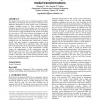Free Online Productivity Tools
i2Speak
i2Symbol
i2OCR
iTex2Img
iWeb2Print
iWeb2Shot
i2Type
iPdf2Split
iPdf2Merge
i2Bopomofo
i2Arabic
i2Style
i2Image
i2PDF
iLatex2Rtf
Sci2ools
WOSP
2005
ACM
2005
ACM
From UML to LQN by XML algebra-based model transformations
The change of focus from code to models promoted by OMG's Model Driven Development raises the need for verification of nonfunctional characteristics of UML models, such as performance, reliability, scalability, security, etc. Many modeling formalisms, techniques and tools have been developed over the years for the analysis of different non-functional characteristics. The challenge is not to reinvent new analysis methods for UML models, but to bridge the gap between UML-based software development tools and different kinds of existing analysis tools. Traditionally, the analysis models were built "by hand". However, a new trend is starting to emerge, that involves the automatic transformation of UML models (annotated with extra information) into various kinds of analysis models. This paper proposes a transformation method of an annotated UML model into a performance model. The mapping between the input model and the output model is defined at a higher abstraction based on ...
| Added | 26 Jun 2010 |
| Updated | 26 Jun 2010 |
| Type | Conference |
| Year | 2005 |
| Where | WOSP |
| Authors | Gordon Ping Gu, Dorina C. Petriu |
Comments (0)

